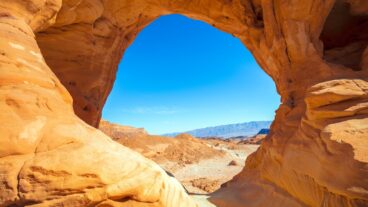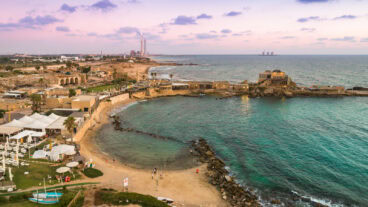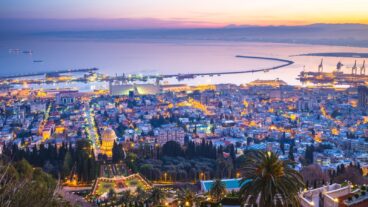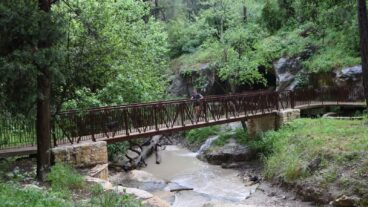Israel offers thrill-seekers everything from surfing and spelunking to paragliding and parkour, in some of the world’s most spectacular scenery. ISRAEL21c takes a look at the top 10.
Extreme sports – the popular term for a slew of inherently dangerous, sometimes countercultural activities – are disproportionately popular in Israel. Israelis love a challenge, and a bit of danger added to the mix is just perfect for thrill-seekers across the country.
“This combination of adrenaline and nature is far more suitable to the Israeli mindset than any high-tech amusement park,” says Moshe Meyers, CEO of Israel Extreme, a company specializing in off-the-beaten-track tourism.
“This tiny country has so many natural sites for every type of extreme sport. We have some of the most beautiful and challenging sites in the world. I don’t know any other country with so many participants,” Meyers tells ISRAEL21c.
Fortunately, this small land has natural settings suitable for every type of extreme sport, from remote desert canyons to snow-capped peaks. And with such a keen local audience already paving the way, tourists from abroad are also rapidly discovering that the country is a great go-to destination for the thrill of their lives.
Our picks for Israel’s 10 most challenging extreme sports:
1. Down below
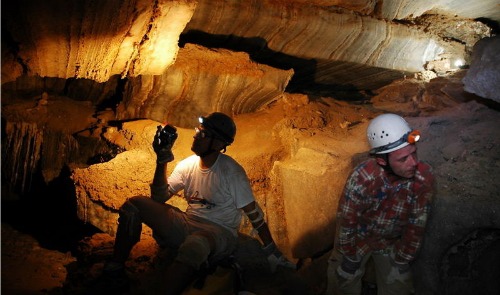
Beyond the obvious airborne, waterborne or ground level sports, going underground is a rapidly developing extreme option in Israel.
“Caving is possibly the most dangerous challenge sport there is,” says Sergey Shipitsin, one of Israel’s most accomplished speleologists (a scientific specialist in caves). “It’s also one of the few activities where you can still go where no one has gone before.”
Shipitsin, 43, tells ISRAEL21c that “Israel is a dream country for the cave explorer,” ranking among spelunkers’ top 10 countries. Israel has four main caving areas: the Jerusalem Hills, Mount Sodom (unique in the world), the Upper Galilee and the Hebron Hills in the West Bank.
Mount Sodom – basically a block of salt rising 230 meters above the Dead Sea – is pierced by labyrinth caverns and tunnels formed by rainwater, including the world’s biggest salt caves. If you know where to look, the Jerusalem Hills have thousands of caves, many of them eminently explorable.
Caving (known as potholing in the UK), which includes climbing, hiking and rappelling, is not an activity to be attempted alone, or without the proper equipment and preparation.
In 2004, Shipitsin and some fellow cavers set up Sarma, a non-profit organization dedicated to cave exploration and rescue, which now has some 3,000 members.
“Israel has many people experienced in both cave exploration and rappelling. We organize challenge trips underground and training courses. You don’t have to be particularly fit – we had children aged seven and a 74-year-old in last weekend’s tour,” he says.
2. Into the abyss
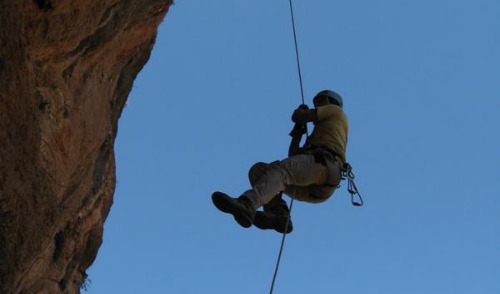
Rappelling – the controlled descent down a rope known as “abseiling” in British English and “snappling” in Hebrew – against the cliffs of the Ramon crater in the Negev, or down wadis in the Judean Desert, produces an unbelievable adrenaline rush.
Israel is blessed with some tremendous rappelling sites, not all of them in the desert. Try Khirbet Oren on Mount Carmel, where the stone wall rises from the valley almost vertically; the Kesh on the border with Lebanon; the prehistoric Pigeons Caves near Karmiel; or the notoriously challenging Black Canyon trail in the Golan Heights, which involves traversing rushing water and hiking through a unique nature reserve.
For training, we counted 12 rock-climbing walls in Ashdod, Haifa, Jerusalem, Kibbutz Ha’Ogen, Kiryat-Ono, Kfar Blum, Petah Tikvah, Ramat Yishai and Tel Aviv.
3. Jump out of a plane
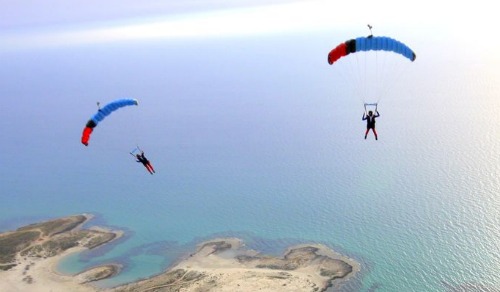
“Anyone who doesn’t parachute once in his or her life is missing out,” says Ziv Kochva, a parachuting guide at the Paradive jump school near Habonim Beach opposite the Carmel mountain range. Paradive is Israel’s largest jump school.
“Parachuting is an empowering experience – a tremendous feeling of freedom. Fear that turns into elation: Nothing can be compared with it,” says Kochva.
Israel has its own skydiving fraternity, many of them graduates of paratroop units or the Israel Defense Forces’ jump school at Tel Nof. Civilian skydivers must take a course and get at least 10 jumps under their belt before being allowed up to 12,000 feet. But the beauty of parachuting is that you don’t need to take a test – anyone can experience it through tandem jumps, harnessed to a guide.
Free-falling is for the particularly strong of heart. “It can be the greatest experience of a lifetime,” Kochva exclaims. “You drop for 50 seconds at 200 kph, then spend five to seven minutes floating down in one of the most beautiful places in the world. It’s a closed area – a nature reserve and the only part of the Mediterranean coastline closed to flights.”
Since opening a decade ago, Paradive has conducted more than 300,000 jumps. Parachuting is definitely not a cheap thrill, yet “all sorts of people – from 12-year-olds to some in their 70s, and not necessarily former paratroopers,” take to the air, says Kochva. “Often they come as a birthday present – it’s a present they never forget.”
4. Fly like a bird
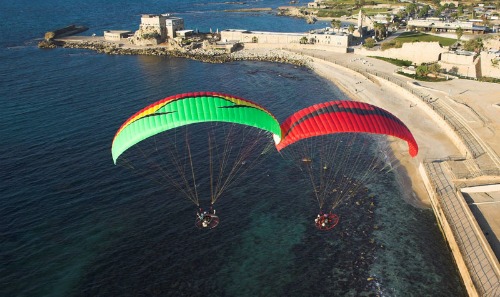
The complementary sports of paragliding and hang gliding answer one of our most basic urges: to fly. A hang glider, with its aluminum frame, requires more skill than a paraglider, which flies more slowly and can land in the smallest field.
Weather conditions are considered ideal in Israel, which is blessed with favorable soaring conditions almost year-round. The country boasts no fewer than 25 official launch pads and thousands of aerial sport fans. There are several popular sites in northern Israel, notably the Manara cliff near Kiryat Shmonah in the Upper Galilee, the Gilboa mountain, Zichron Ya’akov and Mount Tabor above the Jezre’el Valley – an excellent thermal machine where, according to a fourth-century Christian legend, Jesus underwent his Transfiguration. Ever since, the hill has been known as “The Mountain of the Leap.”
A perfect place to start would be off the cliffs overlooking the Mediterranean coastline. Training courses and everything from glide parachutes to flying dune buggies are available for rent at several professional schools.
5. Bicycle country
Mountain biking has become incredibly popular in Israel in the past decade – as has urban bicycling. The country has dozens of biking clubs boasting thousands of members, and as diverse a set of biking trails as you’ll find anywhere in the world.
Myriad routes wind through some of the most distinct terrain, traversing dried-up desert wadis, wind-swept hilltops, lush vegetation and even snow. Downhill enthusiasts will love the Hermon Mountain, while the arid south of the country offers yellow-tinted vistas and the silence of the desert. Riding through the Negev by moonlight is particularly recommended as a unique experience.
6. Just enough for the city
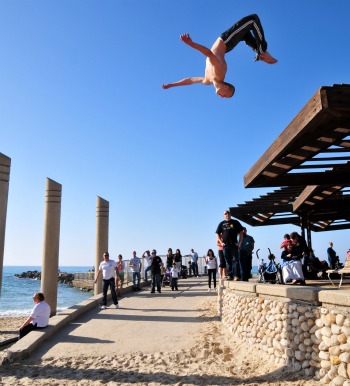
Urban anarchists take to parkour, also known as freerunning — the non-competitive, utilitarian discipline of French origin in which participants use only their bodies’ natural abilities to negotiate a route lined with obstacles. City teenagers, in particular, can increasingly be spotted bounding, climbing, vaulting, rolling and swinging through their local concrete jungle. Sometimes they can even be spotted leaping from one rooftop to the next. But be warned – a few have already been injured and the police are on the lookout for participants … http://www.youtube.com/watch?v=vAgiXxMAPAg
7. Thrills on wheels
You don’t see the same numbers of skateboarders tearing up Israeli streets that you do in North American cities, but skateboarding is alive and kicking in this corner of the Middle East. Israeli cities have many new marble-lined plazas that come alive after office hours. And unlike in other countries, skateboarding is not a crime in Israel and there is no police harassment of skaters.
The Sporteque in Tel Aviv is the best and biggest park in the country with a vert, a mini-ramp, a mini-vert, four quarters, three fun boxes, four banks, two rails, a pyramid and a pro shop selling all the required paraphernalia. Head for Golda Park in central Tel Aviv for the country’s best unofficial skate spot.
Jerusalem boasts a newly rebuilt concrete skate park at Gan Sacher, adjacent to the Supreme Court, while skaters also hang out at Safra Square, next to City Hall. Crazy Roller in Herzliya has a mini-half pipe and a 3.4 meter high vert, and there are also skate parks in Ra’anana, Katzrin and Shoham.
8. Above the metropolis
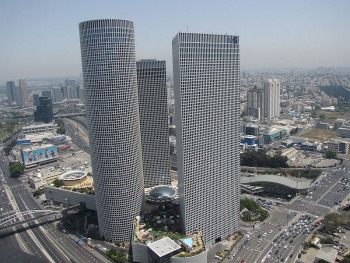
Here’s a challenge for you: Running up to the top of Israel’s highest skyscraper, the Azrieli Tower in Tel Aviv. It started as a wager between a few local nutcases, and has since developed into every wannabe hunk’s rite of passage. The super-fittest can make it up the 1,144 stairs and 54 floors in seven minutes.
9. Surfing safari
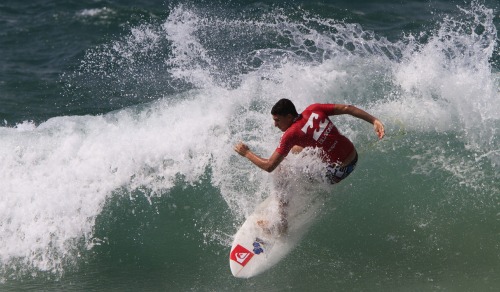
When the waves are high, thousands of surfers and windsurfers flock to the Mediterranean waters all along Israel’s coastline, which is dotted with surf schools. It’s not Hawaii, but the sea often throws up sufficient swell and the shallow, sandy beaches are ideal places to learn how to surf all year round.
The country has produced some fine surfers, including Israel’s first Olympic gold medalist in windsurfing, Gal Fridman. In fact, Israel is a major force in this sport, and has hosted international windsurfing championships. Surfing in Israel began in the 1950s when a young Californian, Dorian Paskowitz immigrated to Israel with six long boards and introduced the sport to Tel Aviv. Today surf schools dot the country’s coastline,
10. Most incongruous sport in the Middle East
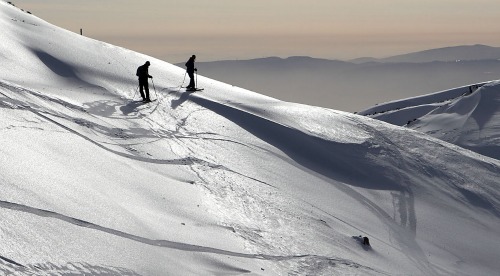
The highest point in Israel, Mount Hermon, hosts Israel’s only ski slope, with three chairlifts and a wide range of ski trails at novice, intermediate and expert levels. But be warned: Not all Israelis are expert skiers even if they think they are, and accidents abound. More family-oriented activities at the ski slope include sledding and Nordic skiing.





